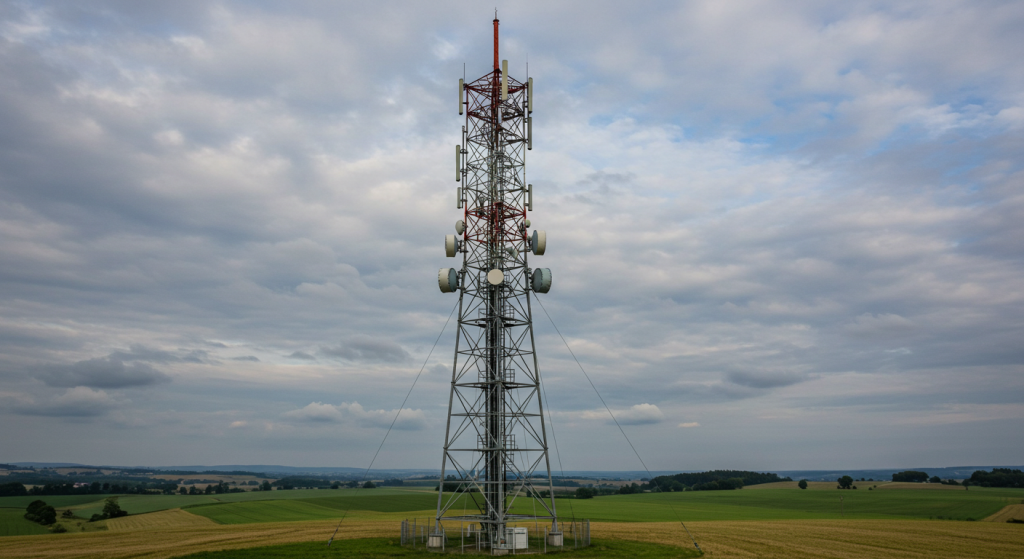Self-Supporting Communication Tower: The Ultimate Guide
2025-07-15
What Exactly is a Self-Supporting Tower?
Use your childhood imagination and think of lattice designs where strings would hold up various telecommunication antennas. A self-supporting communication tower is precisely this: free-standing structures, often made of steel or reinforced concrete, which support antennas, dishes, and cables without the need for guy wires.
- Lattice towers are characterized by cross-braced elements resembling a lattice framework. They can also be classified as monopoles, tubular steel towers, or self-supporting lattice towers due to some specific design features. In addition to the basic structure, each self-supporting tower also integrates platforms, ladders, safety cages, and gear shelters.
- All of these components are strategically placed so that the technicians can service the antennas, backup batteries, and other equipment with ease.
- The reinforced concrete foundation of the tower, while not explicitly mentioned, plays an integral part. This foundation counteracts vertical loads while balancing the weight and provides resistance to wind, ice, or even tipping forces from earthquakes.
- Just like any other civil structure, every single detail of the tower is tailored to meet international standards. Compliance for structural safety is covered by ANSI/TIA‑222 and EN‑1993‑3‑1, and engineering teams ensure compliance at all stages.
Build Efficient and Reliable Telecommunications Infrastructure
Steel structure towers help to provide telecommunication services in Cities and rural areas. They easily blend with the telecommunication networks that already exist. Over the years, integrated technologies have made telecommunication infrastructure more sophisticated and easier to maintain. Steel structures enhance network investments as they provide support in harsh environments and easy as well as reliable integration of networks.
In the case of mobile technologies, a self-supporting communication tower is often overlooked. Guyed mobile towers are divided into two distinct groups: the self-supporting and the free-standing. They are indispensable components as well for cellular, 5G, broadcast, Internet of Things (IoT), and public safety networks. Unlike guyed towers, which rely on cables anchored to the ground, self-supporting towers, which stand on their own, are most suited for dense urban areas and rooftops where space is limited.
Most Frequently Seen Self-Supporting Tower Types
- Lattice Towers (3, 4, even tetrahedral legs)
Picturing a steel Eiffel Tower outfitted with telecom equipment sheds light on the appearance of these towers, which range between 20 to 100 meters in height and possess square or triangular cross-sections and dominate with stability and load-bearing capabilities. This design is especially advantageous in terms of structural efficiency and material economy, which is why the three-legged version is the most common.
- Monopoles
Where site topography is limited to fifty meters, monopole or tubular steel towers ease the design process. These multifunctional antennas, along with their supporting cables, are affixed to a single slender shaft, which is automated at remarkable intervals of spacing. Such monopoles are ideal for space-constrained areas. Some structures may be fully encased using tubular steel, with internal ladders, cable cleating systems, or enormous dome-shaped concrete forms that serve as observation or decorative observation decks.
Why Self-Supporting is a Better Choice Than Guyed Towers?
Choosing a self-supporting tower brings forth numerous clear and compelling benefits:
- Achieved Maximal Efficiency of the Space
Use of meters is more effective in the construction of self-supporting towers located on urban and rooftop installations as opposed to guyed galvanized wire structures that need space for surrounding guide wires.
- Enhancing Shocking Structural Reliability
Structures of this nature are built using high technology and modern design, ensuring reliability against great damage from wind load, ice, or even seismic activity. Stress control within these structures is more reliable in severe weather because of their leg and brace load distribution.
- Modular in nature
Self-supporting towers are modular, and their construction is modular. They are provided with equipped platforms, safety cages, along with other features that empower technicians to easily perform installation and servicing of equipment. Modular self-supporting towers allow for the addition of new antennas or an increase in height by simply bolting on new sections. This feature is beneficial in case multiple operators need to use a single tower, as it makes implementations more cost-effective.

What Goes into Designing One?
- Foundation and Load Management
Every structure begins with a soil test, which determines the type of foundation needed, whether it be shallow spread footing or deep pile. Also, vertical loads, lateral forces from strong winds and seismic activity, and overturning moments need to be incorporated into the design.
- Smart Material Choices
Typically used galvanized steel because of its strength and enduring durability. It is also able to be recycled. In more urban settings where sleek designs are preferred, towers are occasionally painted to blend with the skyline or covered in composites to make them less visually intrusive.
- Safety and Coding Standards
There are stringent safety requirements, and compliance with these requirements is mandatory. ANSI/TIA‑222 for Wind and Ice Loads, Seismic Activity, and Material Strength, alongside European EN 1993-3-1, mandates the design, further showcasing the use of rigorous engineering reasoning.
- Modularity for Convenience
Components of the tower are pre-fabricated in 3-6 m segments, which are later shipped to the site for assembly. To optimize material balance and load distribution, the taller towers taper toward the apex in an inverted pyramid fashion.
- Real-World Installation & Care
Picture a crew sent to construct a tower arriving at the site. The site’s soil is studied meticulously, and the necessary groundwork is laid, including ready prefabricated modules. The crew assembles the parts while fitting ladders, platforms, and safety harnesses needed for work at height. Later, antennas, microwave dishes, and spools of fiber cables are installed, which are verified by a compliance check for ANSI/TIA-222 or Eurocode standards.
Explore Our Most Recent Innovations
- Advanced Eco-Friendly Technological Systems
- Smart Sensing Towers
- 5G Readied Structures
- Rugged Area Remote Deployment Kits
These groundbreaking additions reduce the impact of the towers on the environment while simultaneously increasing operational efficiency.
Conclusion
With the XY Tower self-supporting communication tower, the company is able to provide cutting-edge technology solutions for structural compliance that meet contemporary demands for comprehensive compliance, connectivity, and communication. As multifunctional steel structures, adaptable steel towers serve telecommunication and broadcasting instruments or as foundational supports for emergency communications. Alongside XY Tower, the telecom infrastructure visions can be achieved as we build the future, one steel tower at a time.

Hey, I’m Chunjian Shu
"X.Y. Tower: Reliable, innovative solutions for high-quality towers and electrical equipment with professional service.
